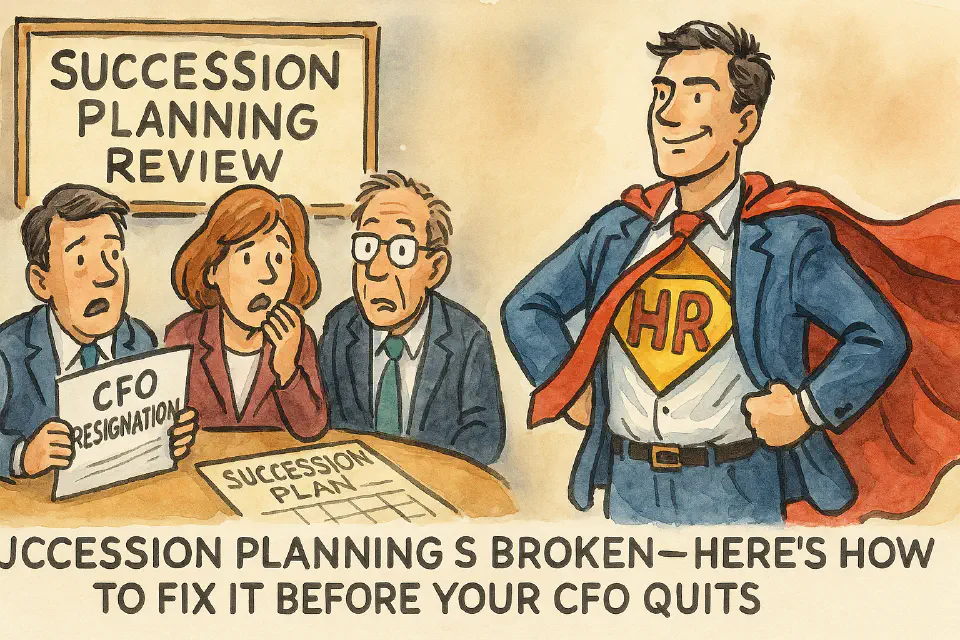
Succession Planning Is Broken—Here’s How to Fix It Before Your CFO Quits
You had a list. You had a plan. Then your CFO quit and no one’s ready. Sound familiar? Welcome to the messy world of traditional succession planning—and how to do it better.
Let’s paint a familiar picture: your CFO resigns out of the blue. You dust off that polished nine-box grid from last year’s talent review, glance at the names, and… suddenly, your confidence evaporates like cheap cologne at a board meeting.
No one’s quite ready. Or worse—they were never supposed to be.
If you’ve ever lived through this kind of moment, congratulations: you’ve encountered the theater of succession planning. It looks strategic on paper. It sounds reassuring in meetings. But when the curtain rises? Everyone’s improvising.
Welcome to corporate succession planning, 2025 edition—still mostly powered by spreadsheets, vague promises, and wishful thinking.
Why We Keep Failing at Succession Planning (Despite All That Effort)
Here’s the kicker: companies spend millions and countless hours reviewing leadership pipelines, assessing potential, and printing glossy talent profiles. And yet? Most succession plans are about as useful as a 2020 business forecast.
Recent data shows:
- Only 49% of leadership roles can be filled internally.
- CHROs say less than 20% of employees are truly ready for critical roles.
- And companies? They’re still rating their own succession processes around 5 out of 10. That’s not just a D+. That’s “let’s hire a search firm” territory.
So why do we keep building these rickety bridges to the future? Let’s get honest.
Let’s Talk About the Real Problems
Succession planning isn’t failing because we don’t care. It’s failing because of what we don’t do:
1. We Rate. We Don’t Develop.
Every year, companies host talent reviews, score leaders in a grid, nod thoughtfully… and then do nothing.
💬 “It doesn’t mean jack s**t if I have a grid full of rated leaders,” one executive confessed. “What are we doing about it?”
Spoiler: not much.
2. Succession Feels Like a Risky Conversation
Why don’t leaders talk about their successors?
Because deep down, they think: “If I train someone to replace me, what happens to me?”
And so they stall. They delay. They wait for “someday.” Until it’s too late.
3. Too Many Roles, Not Enough Focus
Some companies try to plan succession for hundreds of roles. And guess what? Everyone gets overwhelmed, so no one gets developed.
The best companies? They pick their battles.
4. We’re Still Using Excel. In 2025.
Most leaders still manage succession planning with spreadsheets. Meanwhile, TikTok can predict your soulmate and ChatGPT is writing performance reviews. It’s time to upgrade the toolkit.
The 4 Pivots That Actually Work
So how do we escape the Groundhog Day of failed succession? Here’s what the best are doing differently:
🔁 1. Scenario-Based Succession: Plan for Multiple Futures
Instead of asking “who could take this role?”, smart orgs ask:
“Who would thrive if our strategy shifts here, or here, or here?”
That’s what a global apparel giant did when picking their next CEO—they imagined several strategic futures and chose the leader who best fit the likeliest path.
💪 2. Develop, Don’t Just Evaluate
Talent reviews are useful—but they’re not the end game. The best companies take action.
One large consumer goods company designed a 9-month succession accelerator with:
- Executive coaching
- Stretch assignments
- Peer learning cohorts
- And yes, C-suite sponsorship
This wasn’t just “checking the box.” It was creating readiness.
👥 3. Make Leaders Accountable
Succession fails when it’s just an HR thing. It works when executives own it.
💬 “If HR owns succession alone, it’s dead in the water,” one leader told us. And they’re right.
Make every leader a talent scout. Reward them not for hoarding stars, but for growing leaders across the enterprise.
📊 4. Link Succession to Strategy & Outcomes
If you can’t answer why you’re doing succession planning, you’re not doing it right.
Set clear business outcomes:
- Prepare leaders for digital growth
- Ensure DEI at the top
- Support global expansion
And then? Track it. Like any real business initiative.
Final Thought—Wait, Scratch That. Just This:
Succession planning doesn’t have to be a dog-and-pony show. But it will keep failing unless we treat it like strategy, not ceremony.
The future isn’t waiting for a clean nine-box grid. It’s already disrupting your org chart.
So let’s stop pretending and start preparing. Your next leadership crisis might already be on your calendar—and this time, let’s be ready.